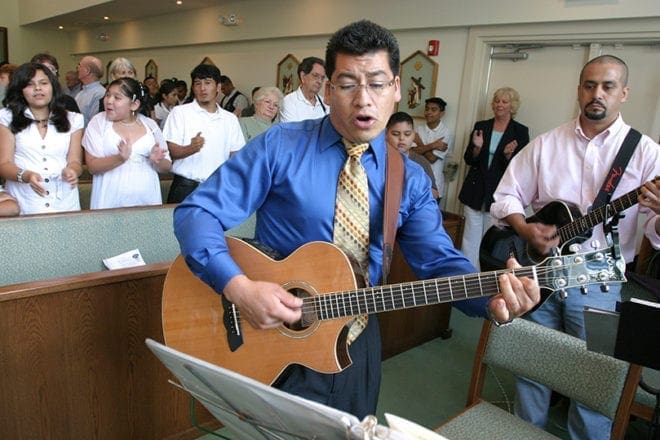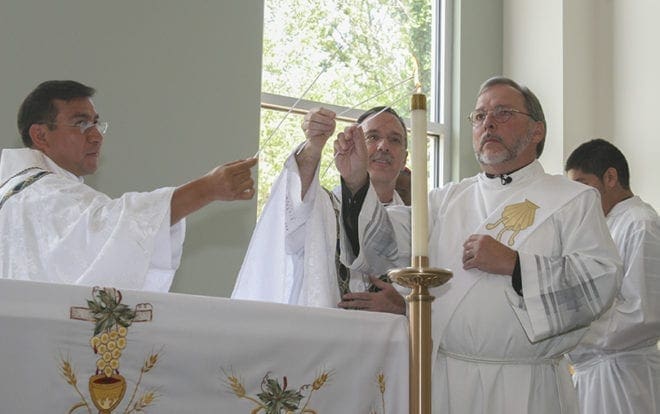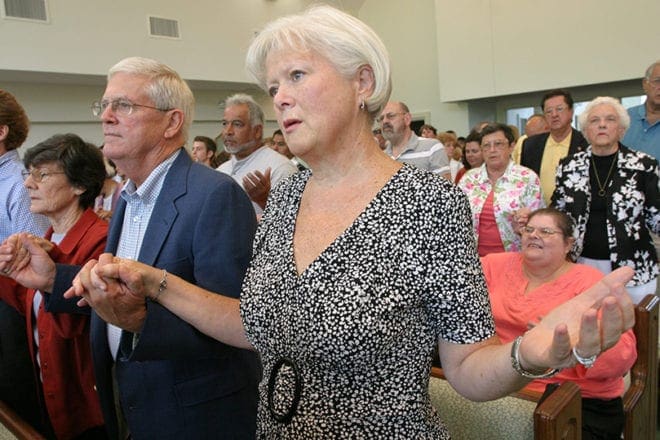 Photo By Michael Alexander
Photo By Michael AlexanderClayton
St. Helena Dedicates New Church, Despite Fire
By STEPHEN O'KANE, Staff Writer | Published September 3, 2009
For 10 years he shepherded St. Helena Church, but on Aug. 23 Bishop-elect Luis Zarama joined Atlanta Archbishop Wilton D. Gregory, visiting priests and the whole community to dedicate its new church building.
St. Helena, a mission of St. Mark Church in Clarkesville, was doubly joyous to celebrate the dedication Mass because the original date of completion was set back when an arson fire gutted the nearly completed building.
The damage, estimated at nearly $400,000, is now undetectable at the church site that is nestled gently against the mountainous backdrop of North Georgia.
Knights of Columbus led the Sunday procession as Father Abel Guerrero-Orta, the current pastor of St. Mark and St. Helena, came next, followed by deacons, priests and the archbishop, entering the church packed with hundreds of parishioners.
Ron Spencer, building committee chairman, and his wife, Ruth, presented Archbishop Gregory with finished plans of the church as well as a photo history of the project, while Tom Davis, who chaired the finance council, gave him the keys to the church.
“It was beautiful,” Spencer said of the liturgy, his first dedication Mass.
Spencer said the Mass and new building were a long time coming. The process began nearly nine years ago when the community began searching for land for a new church. They located and purchased property within two years of that first decision to build.

Jorge Pasaran leads the Spanish choir and congregation in a festive recessional hymn. Photo By Michael Alexander
“We found out in a hurry we couldn’t afford everything we wanted,” said Spencer, a Michigan native who has been part of the mission church for 20 years, since he and his wife moved to Georgia after he retired from teaching.
Original suggestions included building a hall first, where parishioners could gather for Mass while raising money for a new church. But, according to Spencer, “we needed a church more than a hall.”
Nearly 50 percent of parishioners helped out with funding, a large and encouraging portion of the mission community, said Spencer.
However, the St. Helena’s community received devastating news when fire damaged a significant part of the church March 1. The Palm Sunday dedication Mass was postponed, and community members struggled with the reality of the situation as the Georgia Bureau of Investigation found gasoline at the cross-topped building and determined an arsonist started the fire.
Just a few weeks later, renovation was underway. And now, only a few months later, the community came together once again to celebrate a remarkable triumph.
During the homily, Archbishop Gregory called on St. James the Apostle to relay his message on the importance of hospitality and how a building simply represents the way a community displays that hospitality.
“(St.) James does not mince words. He tells us clearly and emphatically that we must be hospitable people,” the archbishop began. “To be Church demands that we are people who know how to welcome others into our midst. … Hospitality is best practiced when everyone is made to feel at home. That is the duty of those who assemble as God’s elect.”

During the lighting of the altar and church, (l-r) St. Helena pastor Father Abel Guerrero Orta, Bishop-elect Luis Zarama and Deacon David Hanson ignite the candle in unison. Photo By Michael Alexander
“Church buildings must reflect the desire and intention of a community to be people who cherish the opportunity to be hospitable,” he continued. “Buildings, after all are only reflections of the people who build them and who use them. Architectural designers have long known and practiced the adage: ‘form follows function.’ A building ought to reflect what its purpose is. A building should help people visualize what goes on within its walls.”
Several hundred people listened to the archbishop speak—some sitting in pews with their families, others standing in the narthex with their children, while many even spilled into the doorway and outside into the warm August sun.
“I have come to St. Helena to bless and dedicate your new place of hospitality, your Church home, your brick and mortar reminder of who you are as a people,” Archbishop Gregory said. “A church building must make the young, the old, the physically impaired, and the stranger feel at home and welcome. In the design of your church home, you have attempted to extend wide the doors of welcome so that people of every background will find a warm welcome within.”
The crowd that listened to Archbishop Gregory fit that description well. The Anglo and Hispanic members of the faith were there, with every age group represented, from babies and toddlers to married couples who have been together for over 50 years.
Following the homily, the church was blessed and anointed with chrism. The concelebrants proceeded throughout the church marking its walls and altar with the holy oil.
The sanctuary was also incensed before being decorated with flowers and lighted with candles for the first time. For Spencer, this was an emotional moment.
“I was doing very well until the lighting ceremony,” he said. “Then I just lost it.”

Lynn and Bob Cowhig celebrated their 40th wedding anniversary on the day of the dedication, Aug. 23. Photo By Michael Alexander
He recalled both Bishop-elect Zarama and Archbishop Gregory looking over to see him weeping and then something happened which he’ll remember for a long time.
“The archbishop came down from the altar and gave me a big hug,” he said, adding that lighted candles represented the culmination of all of the hard work over the last several years.
Upon entering the large entryway, parishioners and visitors are greeted with a vaulted-ceiling narthex, which allows sunshine to reach every nook and cranny. The sanctuary is much the same way, with windows behind the altar overlooking the beautiful Clayton countryside.
Seating has also expanded tremendously, almost doubling capacity from the old 1960s-era church that sits just a few minutes down the road. The office and hall will remain at the old site, while the new site houses the worship space. Ample parking is also included at the new church, as it sits on a large open piece of land with plenty of room.
Spencer said the entire process has been positive and many people contributed to make it possible, from the architect, George Hlavenka, and builder, Ron Cantrell Construction, to Catholic Construction Services and the supportive parishioners.
“I cannot say enough about the people we worked with,” Spencer said. “Everyone was focused on getting it done at the highest quality. … The friends we have at St. Helena’s are just terrific.”
After the Mass, the community gathered at the Rabun County Civic Center to continue the celebration.
“The greatest compliment to be paid your new church house will not be made about the stunningly attractive architecture nor the more inviting gathering space or about the exquisitely efficient use of light and glass nor about the additional storage, office, or meeting space,” Archbishop Gregory told the crowd.
“The highest compliment to be made will come when some stranger who knows nothing of your history or your generous efforts to construct this edifice observes: ‘what an interesting church building and what great and gracious people must worship God therein.’”